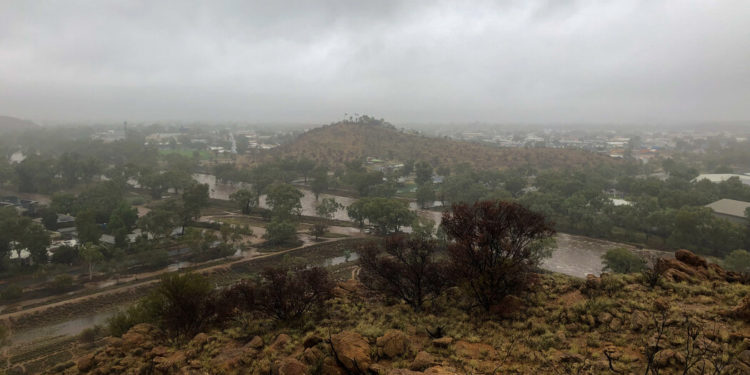By THE NEW YORK TIMES
The Australia Letter is a weekly newsletter from our Australia bureau. Sign up to get it by email.
Whenever there’s rain in the forecast for the desert town of Mparntwe, otherwise known as Alice Springs, the same question usually surfaces: “Do you think the Todd will flow?”
This week, the answer was yes. The normally dry Todd River swelled with water on the back of a week’s worth of rain that dropped 184 mm (about 7.2 inches) from the skies after months of unrelenting heat, according to the Bureau of Meteorology. The rain picked up piles of debris, washed out roads and turned the usually pastel red-yellow landscape of the area in central Australia into a rich tapestry of brown-green.
Local officials issued severe flood warnings, but in a region usually defined by arid heat, people were excited — even more so when the water started to rise. People swarmed the Todd’s banks, reveling in the majestic sight of a river in motion.
It’s something people in this part of the world get to see only a few times a year. Although the land is never completely dry — a rich groundwater table makes itself known through the rows of mature river red gum trees that line the banks — aboveground flows of any significance are contingent on big rain.
John Wischusen, a hydrogeologist based in Alice Springs, said that the usual formula for determining whether the Todd would flow was 40 millimeters of rain at a rate of 50 millimeters per hour. That’s a heavy downpour typical of a summer thunderstorm, but he added that consecutive days of wet weather at a lower intensity also would (and this week, did) tip the scales.
“It’s like a roof and a water tank,” said Mr. Wischusen, explaining how the high concentration of Precambrian rocks (including gneiss and granite) in and around Alice Springs encouraged water runoff. “But the ground underneath has to be wet up to a certain level before it can flow past. That’s why you need a certain amount of rain and or intensity to get water to flow over the ground and into the river channels and through town.”
As it travels, the water recharges the landscape. Animals that previously kept a low profile suddenly show up. “You’ll hear all the frogs that have been dormant in the soil for a year come out and start chirping,” Mr. Wischusen said. Valleys transform into water holes, and groundwater storage systems replenish their stocks.
The water corridors are not what they once where — urbanization, invasive weeds and pollution have transformed the landscape — yet the river ecosystem is healed, nurtured and powered by these annual flows.
“Those big buildings built along the banks of the Todd are pretty hard on the eyes. But after a few flows, you notice they suddenly disappear, swallowed up by the growth of river red gums,” said Peter Renehan, a Central Arrernte man who leads the Centre for Appropriate Technology, a science and technology hub based in Alice Springs. “For us, that’s country doing its work.”
For many years, Mr. Renehan has spearheaded programs and working groups trying to rejuvenate the damaged riverbed. He pointed out trash (from small plastic wrappers to full-fledged mattresses) floating downstream because of illegal campers, gutters that drain too quickly for the river to properly absorb, and the masses of invasive Buffel grass choking the corridors. Unlike native plants, these weeds encircle the bases of old native river gums, thwarting their capacity to serve as a frontline defense against deadly fires, and making it harder for the water to move as it should.
“We really want to be able to shine a light on the water systems within the town to actually show how beautiful it could be and how it used to be,” Mr. Renehan said, adding that the way the town breathes when the river runs is exactly why it warrants time, resources and sustained investment.
“All the negativity around the town just drops away as everyone comes together to view the river.”
There has been a lot of negativity for the town recently, a place noted by national media and politicians as a hotbed for youth crime. This week, the Northern Territory Chief Minister declared a state of emergency for Alice Springs, ordering a youth curfew and — along with other officials — calling on the federal government to send the Australian Federal Police to help ensure safety.
The political mayhem and talk of a “town under siege” stood in stark contrast to the sentiments stirred by the Todd.
Mr. Renehan was blunt: He said the narrative needs to change. He wants government to redirect the energy it pours into law and order toward the protection, preservation and revitalization of the very thing that makes the town tick.
Aboriginal people learn through observation — “feeling and seeing,” he said — not by the government’s “slap in the face” approach of more big buildings and supercharged built environments.
“We think we’re making progress, but then they go and do something like change the height restrictions,” he said, adding: “It’s a never-ending struggle to get them to understand the importance of the river.”
Now here are our stories of the week.
Enjoying the Australia Letter? Sign up here or forward to a friend.







Discussion about this post